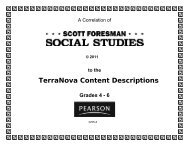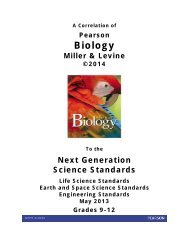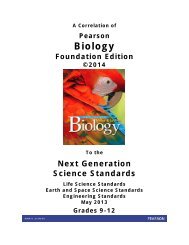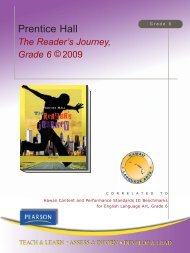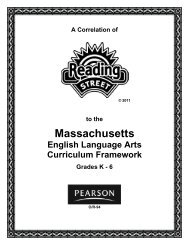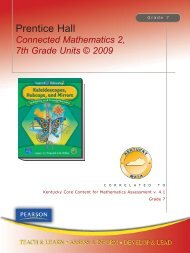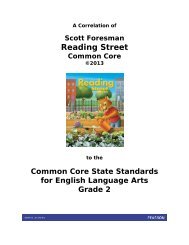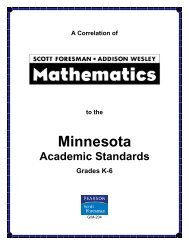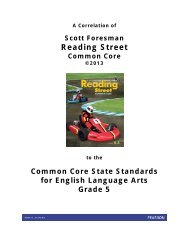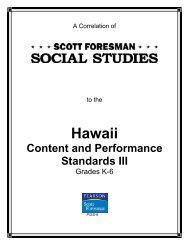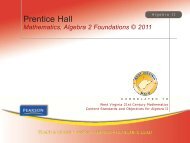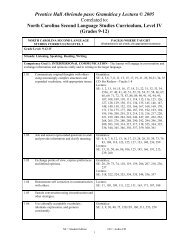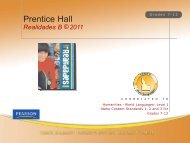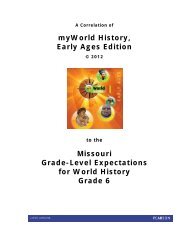Prentice Hall Science Explorer â 16 Book Series © 2009 ... - Pearson
Prentice Hall Science Explorer â 16 Book Series © 2009 ... - Pearson
Prentice Hall Science Explorer â 16 Book Series © 2009 ... - Pearson
Create successful ePaper yourself
Turn your PDF publications into a flip-book with our unique Google optimized e-Paper software.
<strong>Prentice</strong> <strong>Hall</strong> <strong>Science</strong> <strong>Explorer</strong> – <strong>16</strong> <strong>Book</strong> <strong>Series</strong> © <strong>2009</strong><br />
Correlated to:<br />
Connecticut Core <strong>Science</strong> - Content Standards and Expected Performances<br />
(Grades 6-8)<br />
CONNECTICUT CORE SCIENCE - CONTENT<br />
STANDARDS AND EXPECTED<br />
PERFORMANCES<br />
PAGE(S) WHERE TAUGHT<br />
(If submission is not a text, cite<br />
appropriate resource(s))<br />
Content Standards<br />
Energy in the Earth’s Systems – How do external and internal sources of energy affect the<br />
Earth’s systems<br />
6.3 - Variations in the amount of the sun’s energy hitting the Earth’s surface affect daily and<br />
seasonal weather patterns.<br />
Local and regional weather are affected by<br />
the amount of solar energy these areas<br />
receive and by their proximity to a large body<br />
of water.<br />
Weather and Climate<br />
SE/TE: 80-91, 92-105; At Home Activity: 89;<br />
Discover 92; Key Terms: 92; Math Analyzing<br />
Data: 95; <strong>Science</strong> and History: 84; Skills<br />
Activity: 97; Skills Lab: 90-91, 99;<br />
Technology and Society: 100-101; Target<br />
Reading Skills: 92; Try This Activity: 81;<br />
Writing in <strong>Science</strong>: 84<br />
TE: Address Misconceptions: 70F, 85;<br />
Background: 84, 100; Build Inquiry: 85, 87,<br />
95, 97; Differentiated Instruction; 83, 84, 87,<br />
93, 94; Integrate Health: 82; Monitor<br />
Progress: 81, 83, 85, 93, 95, 97; Review and<br />
Assessment: 104; Standardized Test Prep:<br />
105; Teach key Concepts: 93, 94, 96; Use<br />
Visuals: 81, 83, 85, 86, 88, 98<br />
Expected Performances<br />
C7. Describe the effect of heating on the<br />
movement of molecules in solids, liquids and<br />
gases.<br />
Chemical Building Blocks<br />
SE/TE: 42-47; At Home Activity: 47; Discover<br />
Activity: 42; Key Terms: 42; Section<br />
Assessment: 47; Target Reading Skills: 42;<br />
Try This Activity: 46<br />
TE: Build Inquiry: 44; Differentiated<br />
Instruction: 43, 44; Monitor Progress: 43, 45,<br />
47; Performance Assessment: 47; Teacher<br />
Demo: 44, 46; Teach Key Concepts: 43, 45;<br />
Use Visuals: 43<br />
C8. Explain how local weather conditions are<br />
related to the temperature, pressure and<br />
water content of the atmosphere and the<br />
proximity to a large body of water.<br />
Weather and Climate<br />
SE/TE: 80-91, 92-105; At Home Activity: 89;<br />
Discover 92; Key Terms: 92; Math Analyzing<br />
Data: 95; <strong>Science</strong> and History: 84; Skills<br />
Activity: 97; Skills Lab: 90-91, 99;<br />
Technology and Society: 100-101; Target<br />
Reading Skills: 92; Try This Activity: 81;<br />
Writing in <strong>Science</strong>: 84<br />
34<br />
SE = Student Edition - TE = Teacher Edition



